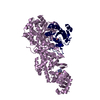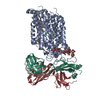[English] 日本語
 Yorodumi
Yorodumi- EMDB-5931: Dictyostelium dynein microtubule binding domain bound to a 15-pro... -
+ Open data
Open data
- Basic information
Basic information
| Entry | Database: EMDB / ID: EMD-5931 | |||||||||
|---|---|---|---|---|---|---|---|---|---|---|
| Title | Dictyostelium dynein microtubule binding domain bound to a 15-protofilament microtubule | |||||||||
 Map data Map data | 3D reconstruction of dynein microtubule binding domain-microtubule complex | |||||||||
 Sample Sample |
| |||||||||
 Keywords Keywords | Motor protein / Cytoskeleton / Retrograde transport / Nuclear segregation / AAA+ ATPase / GTPase | |||||||||
| Function / homology |  Function and homology information Function and homology informationminus-end-directed vesicle transport along microtubule / early phagosome membrane / Aggrephagy / COPI-mediated anterograde transport / CTPase activity / phagolysosome membrane / Neutrophil degranulation / phagosome maturation / microtubule motor activity / minus-end-directed microtubule motor activity ...minus-end-directed vesicle transport along microtubule / early phagosome membrane / Aggrephagy / COPI-mediated anterograde transport / CTPase activity / phagolysosome membrane / Neutrophil degranulation / phagosome maturation / microtubule motor activity / minus-end-directed microtubule motor activity / cytoplasmic dynein complex / dynein light intermediate chain binding / motile cilium / nuclear migration / ATPase complex / dynein intermediate chain binding / endocytic vesicle / mitotic spindle assembly / cytoplasmic microtubule / cytoplasmic microtubule organization / tubulin binding / mitotic spindle organization / structural constituent of cytoskeleton / microtubule cytoskeleton organization / neuron migration / mitotic cell cycle / cell cortex / microtubule binding / Hydrolases; Acting on acid anhydrides; Acting on GTP to facilitate cellular and subcellular movement / microtubule / hydrolase activity / GTPase activity / centrosome / GTP binding / ATP hydrolysis activity / ATP binding / metal ion binding / identical protein binding / cytoplasm Similarity search - Function | |||||||||
| Biological species |   | |||||||||
| Method | helical reconstruction / cryo EM / Resolution: 8.2 Å | |||||||||
 Authors Authors | Uchimura S / Fujii T / Takazaki H / Ayukawa R / Nishikawa Y / Minoura I / Hachikubo Y / Kurisu G / Sutoh K / Kon T ...Uchimura S / Fujii T / Takazaki H / Ayukawa R / Nishikawa Y / Minoura I / Hachikubo Y / Kurisu G / Sutoh K / Kon T / Namba K / Muto E | |||||||||
 Citation Citation |  Journal: J Cell Biol / Year: 2015 Journal: J Cell Biol / Year: 2015Title: A flipped ion pair at the dynein-microtubule interface is critical for dynein motility and ATPase activation. Authors: Seiichi Uchimura / Takashi Fujii / Hiroko Takazaki / Rie Ayukawa / Yosuke Nishikawa / Itsushi Minoura / You Hachikubo / Genji Kurisu / Kazuo Sutoh / Takahide Kon / Keiichi Namba / Etsuko Muto /  Abstract: Dynein is a motor protein that moves on microtubules (MTs) using the energy of adenosine triphosphate (ATP) hydrolysis. To understand its motility mechanism, it is crucial to know how the signal of ...Dynein is a motor protein that moves on microtubules (MTs) using the energy of adenosine triphosphate (ATP) hydrolysis. To understand its motility mechanism, it is crucial to know how the signal of MT binding is transmitted to the ATPase domain to enhance ATP hydrolysis. However, the molecular basis of signal transmission at the dynein-MT interface remains unclear. Scanning mutagenesis of tubulin identified two residues in α-tubulin, R403 and E416, that are critical for ATPase activation and directional movement of dynein. Electron cryomicroscopy and biochemical analyses revealed that these residues form salt bridges with the residues in the dynein MT-binding domain (MTBD) that work in concert to induce registry change in the stalk coiled coil and activate the ATPase. The R403-E3390 salt bridge functions as a switch for this mechanism because of its reversed charge relative to other residues at the interface. This study unveils the structural basis for coupling between MT binding and ATPase activation and implicates the MTBD in the control of directional movement. | |||||||||
| History |
|
- Structure visualization
Structure visualization
| Movie |
 Movie viewer Movie viewer |
|---|---|
| Structure viewer | EM map:  SurfView SurfView Molmil Molmil Jmol/JSmol Jmol/JSmol |
| Supplemental images |
- Downloads & links
Downloads & links
-EMDB archive
| Map data |  emd_5931.map.gz emd_5931.map.gz | 427.1 KB |  EMDB map data format EMDB map data format | |
|---|---|---|---|---|
| Header (meta data) |  emd-5931-v30.xml emd-5931-v30.xml emd-5931.xml emd-5931.xml | 11.2 KB 11.2 KB | Display Display |  EMDB header EMDB header |
| Images |  400_5931.gif 400_5931.gif 80_5931.gif 80_5931.gif | 142.7 KB 7.6 KB | ||
| Archive directory |  http://ftp.pdbj.org/pub/emdb/structures/EMD-5931 http://ftp.pdbj.org/pub/emdb/structures/EMD-5931 ftp://ftp.pdbj.org/pub/emdb/structures/EMD-5931 ftp://ftp.pdbj.org/pub/emdb/structures/EMD-5931 | HTTPS FTP |
-Validation report
| Summary document |  emd_5931_validation.pdf.gz emd_5931_validation.pdf.gz | 302.8 KB | Display |  EMDB validaton report EMDB validaton report |
|---|---|---|---|---|
| Full document |  emd_5931_full_validation.pdf.gz emd_5931_full_validation.pdf.gz | 302.3 KB | Display | |
| Data in XML |  emd_5931_validation.xml.gz emd_5931_validation.xml.gz | 5.1 KB | Display | |
| Arichive directory |  https://ftp.pdbj.org/pub/emdb/validation_reports/EMD-5931 https://ftp.pdbj.org/pub/emdb/validation_reports/EMD-5931 ftp://ftp.pdbj.org/pub/emdb/validation_reports/EMD-5931 ftp://ftp.pdbj.org/pub/emdb/validation_reports/EMD-5931 | HTTPS FTP |
-Related structure data
| Related structure data |  3j6pMC M: atomic model generated by this map C: citing same article ( |
|---|---|
| Similar structure data |
- Links
Links
| EMDB pages |  EMDB (EBI/PDBe) / EMDB (EBI/PDBe) /  EMDataResource EMDataResource |
|---|---|
| Related items in Molecule of the Month |
- Map
Map
| File |  Download / File: emd_5931.map.gz / Format: CCP4 / Size: 3.7 MB / Type: IMAGE STORED AS FLOATING POINT NUMBER (4 BYTES) Download / File: emd_5931.map.gz / Format: CCP4 / Size: 3.7 MB / Type: IMAGE STORED AS FLOATING POINT NUMBER (4 BYTES) | ||||||||||||||||||||||||||||||||||||||||||||||||||||||||||||||||||||
|---|---|---|---|---|---|---|---|---|---|---|---|---|---|---|---|---|---|---|---|---|---|---|---|---|---|---|---|---|---|---|---|---|---|---|---|---|---|---|---|---|---|---|---|---|---|---|---|---|---|---|---|---|---|---|---|---|---|---|---|---|---|---|---|---|---|---|---|---|---|
| Annotation | 3D reconstruction of dynein microtubule binding domain-microtubule complex | ||||||||||||||||||||||||||||||||||||||||||||||||||||||||||||||||||||
| Projections & slices | Image control
Images are generated by Spider. | ||||||||||||||||||||||||||||||||||||||||||||||||||||||||||||||||||||
| Voxel size | X=Y=Z: 1.37 Å | ||||||||||||||||||||||||||||||||||||||||||||||||||||||||||||||||||||
| Density |
| ||||||||||||||||||||||||||||||||||||||||||||||||||||||||||||||||||||
| Symmetry | Space group: 1 | ||||||||||||||||||||||||||||||||||||||||||||||||||||||||||||||||||||
| Details | EMDB XML:
CCP4 map header:
| ||||||||||||||||||||||||||||||||||||||||||||||||||||||||||||||||||||
-Supplemental data
- Sample components
Sample components
-Entire : Dictyostelium dynein microtubule binding domain bound to a 15-pro...
| Entire | Name: Dictyostelium dynein microtubule binding domain bound to a 15-protofilament microtubule |
|---|---|
| Components |
|
-Supramolecule #1000: Dictyostelium dynein microtubule binding domain bound to a 15-pro...
| Supramolecule | Name: Dictyostelium dynein microtubule binding domain bound to a 15-protofilament microtubule type: sample / ID: 1000 Oligomeric state: one trimer of microtubule binding domain bound to a 15-protofilament microtubule Number unique components: 2 |
|---|
-Macromolecule #1: Dynein microtubule binding domain
| Macromolecule | Name: Dynein microtubule binding domain / type: protein_or_peptide / ID: 1 / Recombinant expression: Yes |
|---|---|
| Source (natural) | Organism:  |
| Recombinant expression | Organism:  |
-Macromolecule #2: Tubulin dimer
| Macromolecule | Name: Tubulin dimer / type: protein_or_peptide / ID: 2 / Recombinant expression: Yes |
|---|---|
| Source (natural) | Organism:  |
| Recombinant expression | Organism:  |
-Experimental details
-Structure determination
| Method | cryo EM |
|---|---|
 Processing Processing | helical reconstruction |
| Aggregation state | filament |
- Sample preparation
Sample preparation
| Buffer | pH: 7 Details: 20mM PIPES-KOH, 10mM K-acetate, 4mM MgSO4, 1mM EGTA |
|---|---|
| Grid | Details: Quantifoil holey carbon molybdenum grid (R1.2/1.3, Quantifoil) |
| Vitrification | Cryogen name: ETHANE / Chamber humidity: 100 % / Instrument: FEI VITROBOT MARK II / Method: Blot for 3.5 seconds before plunging |
- Electron microscopy
Electron microscopy
| Microscope | JEOL 3200FSC |
|---|---|
| Temperature | Average: 50 K |
| Specialist optics | Energy filter - Name: Omega filter |
| Date | Nov 5, 2012 |
| Image recording | Category: CCD / Film or detector model: TVIPS TEMCAM-F415 (4k x 4k) / Number real images: 1407 / Average electron dose: 20 e/Å2 |
| Electron beam | Acceleration voltage: 200 kV / Electron source:  FIELD EMISSION GUN FIELD EMISSION GUN |
| Electron optics | Calibrated magnification: 109489 / Illumination mode: FLOOD BEAM / Imaging mode: BRIGHT FIELD / Nominal defocus max: 1.5 µm / Nominal defocus min: 1.0 µm / Nominal magnification: 60000 |
| Sample stage | Specimen holder model: JEOL 3200FSC CRYOHOLDER |
- Image processing
Image processing
| Final reconstruction | Applied symmetry - Helical parameters - Δz: 11.0 Å Applied symmetry - Helical parameters - Δ&Phi: 23.8 ° Applied symmetry - Helical parameters - Axial symmetry: C1 (asymmetric) Algorithm: OTHER / Resolution.type: BY AUTHOR / Resolution: 8.2 Å / Resolution method: OTHER / Software - Name: SPIDER |
|---|---|
| CTF correction | Details: CTFFIND3 Each particle |
 Movie
Movie Controller
Controller
















 Z (Sec.)
Z (Sec.) Y (Row.)
Y (Row.) X (Col.)
X (Col.)






















